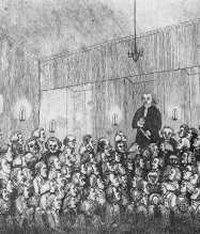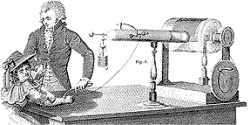James Graham
(1745 - 1794)




Medical school drop-out James Graham was noted for his love of ether. He inhaled an ounce or two each day in later life, "with manifest placidity and enjoyment". In the early decades of the 19th century, "ether frolics" and convivial "laughing gas" parties were to become popular among medical students, research scientists and mountebanks alike. Unfortunately, the frivolity they spawned seems to have overshadowed their revolutionary potential as anaesthetics for pain-free surgery.Even by the standards of the age, James Graham must be accounted something of a quack. The son of a saddler, he was born and educated in Edinburgh. In his twenties, he emigrated to America, where he was favourably impressed by the electrical experiments of Benjamin Franklin. It was here that Graham conceived his guiding idea that "electricity invigorates the whole body and remedies all physical defects".
In 1775, Graham moved to London. He devised electrical therapy devices whose prescribing indications were very flexibly defined. Graham's method of therapy consisted of giving electric jolts to his patients by means of an assortment of sumptuously designed electrical crowns and thrones.
Graham reportedly had a charismatic personality. The lure of his spectacular medical breakthroughs allowed him to rub shoulders with the Prince of Wales, the Duchess of Devonshire, and the crème de la crème of aristocratic high society. Cure-alls such as his "famous aetherial and balsamic medicine" and his "elixir of life" promised the key to immortality and eternal youth. They sounded more enticing than a mainstream regimen of leeches and blood-letting. Another invigorating option available to his clientèle was the "earth bath". It promoted better health via burial up to one's chin in warm earth.
Discerning clients could pay premium rate prices for more exotic treatment. Electrical therapies on offer at Graham's "Temple of Health and Hymen" included "magnetic thrones"; electrically charged baths; and £50 per night "celestial beds" stuffed with stallion hair and fitted with huge magnets to relieve male erectile dysfunction. Scantily clad nymphets or "Goddess of Health" were on hand to encourage a healing atmosphere.
In his later years, Graham became more eccentric. With debts mounting and client confidence waning, he returned to Edinburgh. Graham founded the now defunct The New Jerusalem Church; its membership never exceeded one. His letters now bore the signature, "Servant of Lord, O.W.L." Graham's final book, How to Live for Many Weeks or Months or Years Without Eating Anything Whatsoever, now out of print, took caloric restriction beyond the bounds of sense and gained no surviving converts.
In fairness to Graham and his electrical therapy, it should be recalled that the mechanism underlying what is still our most effective treatment for refractory depression, namely electroconvulsive therapy (ECT), is no less mysterious than any of his nostrums.
HOME
Search
Resources
Snapshots
Utopian Surgery
The Good Drug Guide
Utopian Pharmacology
Refs and Further Reading
Anaesthesia and Anaesthetics
Aether(c.1761) by Mathew Turner
Critique of Aldous Huxley's Brave New World